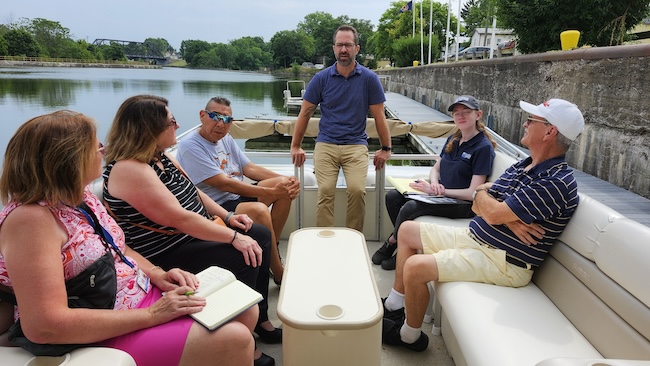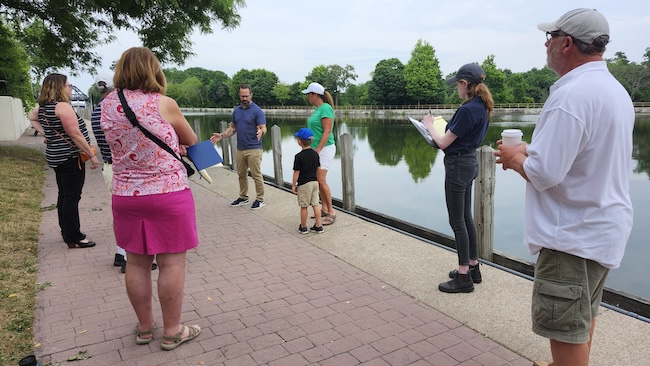Newly built Seneca Chief will visit Medina and Brockport in August
Replica boat will travel full Erie Canal next year to celebrate bicentennial
MEDINA – A traditionally-built, full-sized replica of the Erie Canal boat Seneca Chief will be visiting towns along the Erie Canal on a sea trial in preparation for a trip from Buffalo to New York City during the 200th anniversary of the Erie Canal in 2025.
The boat was constructed by the Buffalo Maritime Center, whose president and development officer met with officials in Medina this morning to discuss upcoming visits. Executive director Brian Trzeciak and development officer Katie Osborn were greeted by Medina mayor Marguerite Sherman; Jim Hancock, chair of Medina’s Tourism Committee; Dawn Borquet, Orleans County tourism director; Kelly Kiebala, director of Orleans County Job Development; Heather Farnsworth Hungerford from Bent’s Opera House; and Brian Hellner, former vice president of the Buffalo Maritime Center and operator of cruises on the canal in Medina.
On its trial run this summer, the Seneca Chief will spend the afternoon and night in Medina on Aug. 12, en route to Brockport, and again on Aug. 16 on their way back to Buffalo.
Tentative plans call for the boat to be open to the public from 4 to 7 p.m. both days. There will be no charge, but donations will be appreciated.

Tourism personnel meet on Brian Hellner’s tour boat to discuss the August visit of the replica canal boat Seneca Chief. Clockwise from left are Dawn Borchet, director of Orleans County Tourism; Kelly Kiebala, director of Orleans County Job Development; Brian Trzeciak, executive director of the Buffalo Maritime Center; Katie Osborn, development officer of the Maritime Center; and Jim Hancock, chair of Medina Tourism Committee.
The Seneca Chief has a crew of 18 to 20 people, who usually sleep on the boat or camp nearby. In Medina, Hungerford has tentatively invited them to use the rooms at the Opera House, where plans include having food there for the crew and the public.
Sherman volunteered to have the village set up a tent in the canal basin for an exhibit and displays of the Erie Canal and informative talks.
Local musician and busker Rob Robinson has agreed to play guitar for a sing-along of canal songs. He used to sing and play on the tour boat run by the former Apple Grove Inn, so he very familiar with songs of the canal.
During tours of the boat and possibly after supper at the Opera House, there will be historic presentations.
The idea to build a replica of the Seneca Chief was that of John Montague, founder and director emeritus of the Buffalo Maritime Center, and a retired professor in the Design Department at Buffalo State College.
Mongague grew up in St. Petersburg, Fla., where he learned to love boats and water. One of the first things he did in Buffalo was to start a boat program at Buffalo State, with the goal of reviving interest in Buffalo as a harbor.
He said people had spent a lot of time trying to redevelop Buffalo’s waterfront, and Montague said, “Why don’t we build a canal boat?”
When he retired from teaching in 2006, he took the boat program with him and started his own non-profit organization. He knew he had to get people to realize Buffalo was not just a rust-belt city, but a maritime city. He built several boats, but kept going back to the idea of a canal boat.
In 2017 Buffalo re-dug the canal and created Canalside.
“Now it is a serious site,” Montague said. “Let’s build a couple of canal boats, and create the ambiance of what this place used to look like.”
He not only wanted to build ambiance of what the area originally looked like, but he wanted to bring focus to the area.
“I wanted it to be an educational project, to bring people in and build a boat in public,” he said. “We wanted people to see it and ask questions.”
They finally got permission to build it in the Longshed at Canalside by the Naval Park.

Brian Hellner, left, welcomed tourism personnel on his boat Monday to discuss plans for the trial visit in August of the replica Seneca Chief. With him are Medina Mayor Marguerite Sherman with her grandson Henry and Heather Farnsworth Hungerford from Bent’s Opera House.
Montague wrote an article in 2018 about the bi-centennial of the canal coming up, and how everybody along the canal was thinking of what they could do. That led to a meeting with the Buffalo Evening News editorial board.
A man in Clarence saw the article and came to the boat shop in Buffalo, where Montague took him on a tour.
He asked how they were going to pay for the boat, and Montague started to explain their ideas for fundraising.
Then the man said, “I’ll pay for it.”
“Our jaws dropped,” Montague said. “The following Wednesday, $800,000 was in our account.”
The project was one of the largest community boat-building projects anywhere in the world at the time, and one of very few being built on public display, Montague said. From the beginning, the public was encouraged to become part of the project by helping to build and acting as public greeters.
The boat’s keel, frames and other structural timbers are built of white oak. The keelson is a single 60-foot long piece of reclaimed Douglas Fir, which their website says was previously used in the early 1900s as a gin pole crane.
Planking is two layers of one-inch thick cypress with a waterproof dynel cloth set in epoxy between the layers. The outler layer of planking is caulked with cotton. This combination of modern and traditional planking methods should help the boat stay watertight even if it spends winters out of the water, builders say.
The finished boat is 73 feet long, 12 feet six inches wide and weighs more than 40 tons.
What amazed Montague most about building the Seneca Chief was the fact it was accomplished with more than 200 volunteers and only two paid staff.
The Erie Canal was built to connect people into one unified state, Montague said.
“We are doing what the Erie Canal did,” he said. “We are creating a bond between communities. We are connecting people in one unified state.”
The Seneca Chief opened the Erie Canal in 1825, carrying Governor DeWitt Clinton from Buffalo to New York City, where they participated in a “wedding of the waters.”
Next summer the Seneca Chief will depart Sept. 24 on the voyage from Buffalo to New York Harbor, stopping at those same cities along the way as Governor Clinton, and encouraging them to educate their communities and to learn about the Erie Canal’s past, its present and to create a shared vision of its future.
The trial run this summer only goes to Rochester, making stops in Lockport, Medina (coming and going), Brockport, Rochester and back to Buffalo.




































































